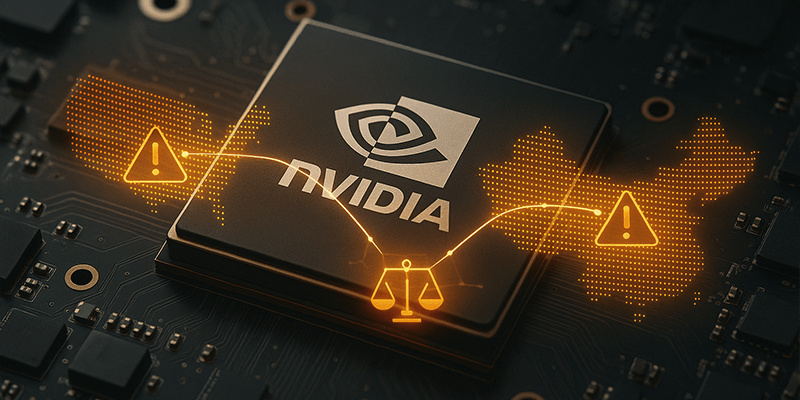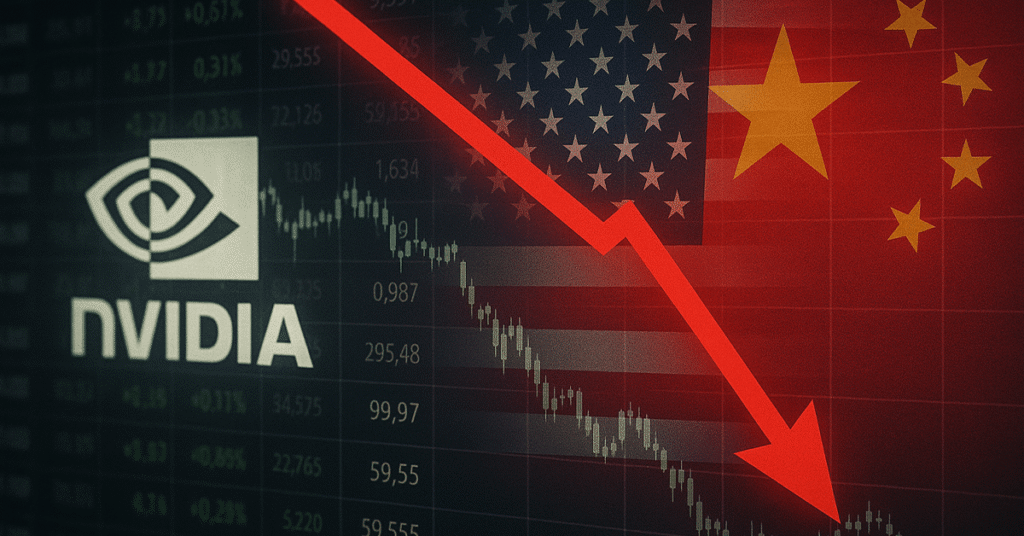The Nvidia China trade impact is front and center as investors pore over the chipmaker’s latest earnings. With U.S.–China trade dynamics escalating—spanning tariffs, export bans, and national security concerns—Nvidia’s dependence on China has become both a strength and a vulnerability. The big question for 2025: Can Nvidia maintain its growth momentum if the U.S.–China tech cold war intensifies?
Why China Matters So Much to Nvidia
China isn’t just another market for Nvidia—it’s one of its largest revenue engines.
- Up to 25% of Nvidia’s sales come from China, including datacenter GPUs used in AI, cloud, and research.
- Chinese tech firms like Alibaba, Tencent, and ByteDance rely heavily on Nvidia’s chips for AI workloads.
- With the AI boom in full swing, demand for H100 and A100 GPUs has been surging—until U.S. restrictions entered the scene.
In short: Nvidia’s growth story and China are deeply intertwined.
The U.S.–China Trade Tensions Driving Market Uncertainty
1. U.S. Export Controls
The U.S. government has tightened rules on selling advanced GPUs to China, citing concerns that they could be used in military or surveillance applications. Nvidia was forced to create “China-compliant” versions of its chips (like the H800) with restricted performance.
2. Chinese Retaliation
China, in turn, has imposed restrictions on critical materials (like gallium and germanium) essential for chip manufacturing. This tit-for-tat raises costs and uncertainty for U.S. chipmakers.
3. Tariff Pressure
Trump and other political voices have warned of new tariffs on Chinese electronics and tech supply chains, potentially hitting Nvidia’s ecosystem of contract manufacturers and assembly partners.
Nvidia Earnings: What Investors Are Watching
During its most recent earnings call, Nvidia highlighted both record-breaking demand for AI chips and headwinds from export restrictions.
Key takeaways:
- Revenue diversification: Nvidia is pivoting aggressively toward markets like India, Southeast Asia, and the Middle East to reduce reliance on China.
- Supply chain resilience: Management reassured investors it is building redundant supply routes outside China.
- Policy risk baked in: Nvidia warned that further tightening of U.S. trade rules could cut off billions in potential sales.
The Investor Lens: What “Nvidia China Trade Impact” Really Means
For investors, the Nvidia-China story isn’t just about geopolitics—it’s about valuation, growth, and volatility.
| Factor | Bullish Case | Bearish Case |
|---|---|---|
| AI Demand | Global hunger for GPUs remains unmatched | China sales restrictions slow momentum |
| Diversification | Expanding into new global markets | Risk of losing foothold in world’s 2nd largest economy |
| Political Climate | Possibility of U.S.–China compromise | Tariffs & sanctions intensify tech cold war |
Translation: Nvidia could remain the AI king, but it may trade like a political football.
Lessons From Past Trade Clashes
History shows how tech firms get caught in the crossfire:
- Huawei (2019): Blacklisted by U.S., lost access to chips and Google services.
- Apple (2020–2022): Heavily reliant on China, faced boycott campaigns.
- Nvidia (2025): Now the new focal point of geopolitical chess.
As one analyst quipped: “Owning Nvidia stock today is like owning oil companies during Middle East crises—fundamentals matter, but geopolitics can swing the market overnight.”

What’s Next for Nvidia and Investors
- Watch Washington: Export control updates could directly hit Nvidia’s top line.
- Track Chinese Policy: Retaliation could expand to rare earth exports or broader tech bans.
- Look for Partnerships: Nvidia may increase joint ventures with non-U.S. firms to skirt restrictions.
- Brace for Volatility: Earnings will remain hostage to political headlines as much as product launches.
FAQ: Nvidia China Trade Impact
Q1: How much of Nvidia’s revenue comes from China?
Around 20–25%, depending on the quarter and product mix.
Q2: Why is the U.S. restricting Nvidia’s chip sales to China?
Due to national security concerns that advanced GPUs could fuel Chinese military or surveillance systems.
Q3: How has Nvidia responded?
By designing limited-performance versions of chips for China and expanding into new markets.
Q4: Could Nvidia lose its Chinese business completely?
It’s possible if restrictions tighten further, but Nvidia is working on diversification.
Q5: What does this mean for investors?
Expect high volatility tied to geopolitical news, not just product cycles.
Conclusion
The Nvidia China trade impact is more than a headline—it’s a bellwether for how tech, trade, and geopolitics collide in 2025. Investors watching Nvidia’s earnings aren’t just measuring GPU demand; they’re gauging the future of U.S.–China relations. For now, Nvidia sits at the intersection of AI innovation and global politics—and that makes its future as unpredictable as the next round of tariffs.
Are you bullish or cautious on Nvidia given the trade risks? Share your take in the comments, and don’t forget to subscribe for more global tech market insights.

